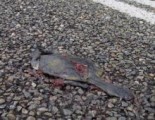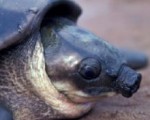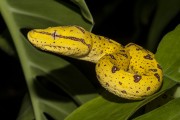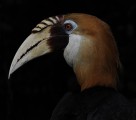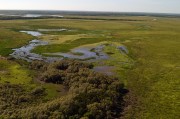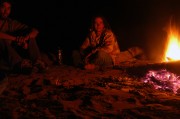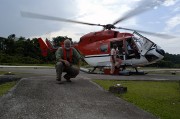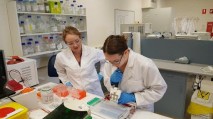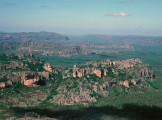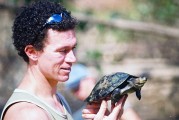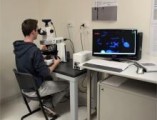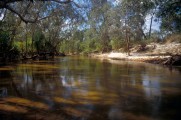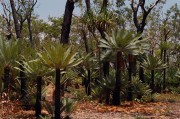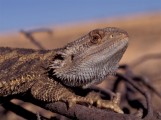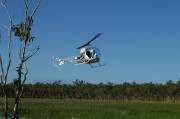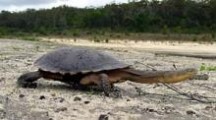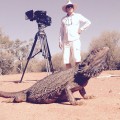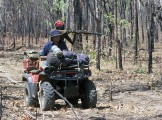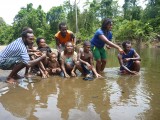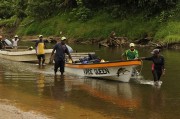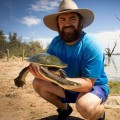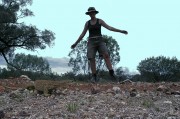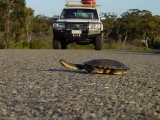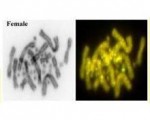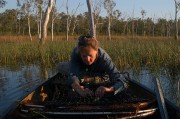This review appeared recently in the Australian Journal of Zoology, where it was accompanied by a response by the authors. I encourage you to read both the review below and the response. Another pespective has been published by Ricky-J Spencer.
Freshwater Turtles of Australia by John Cann and Ross Sadlier is an updated version of John Cann's earlier book on the same topic – it is a spectacular expose of the diversity and form of the unusual turtle fauna of Australia, dominated as it is by the family Chelidae. The book is beautifully illustrated and accompanied by a wealth of experience that John has accumulated through decades of passionate enquiry. No-one has contributed more than John Cann to bringing the diversity in varieties, subspecies and species to light, through many, many hours on the road following leads and seeking out new forms of turtle. His personal experiences come out again and again in the book, to delight the reader with intriguing detective work on the travels of the early collectors through to his own stories on the search for the elusive petshop turtle, now named Elusor macrurus (Cann and Legler 1994). John’s 50 years of engagement with these intriguing animals have led to unique insights to their natural history that are presented in the species accounts. Like its earlier version, Freshwater Turtles of Australia is a must in the library of anyone who shares our passion for this fascinating group of reptiles.

The book begins with a brief account of the challenges faced by Australian freshwater turtles in a modern human-dominated world. Many of these challenges stem from water resource development – water extraction for agriculture, impoundment, and associated alteration to the magnitude, timing and frequency of environmental flows. Particularly impacted, according to the authors, are species that depend on well-oxygenated waters, those that depend in part on extraction of oxygen directly from the water to supplement their aerial breathing (Rheodytes leukops, Elseya sp., and Myuchelys sp.). There are issues of degradation of instream and riparian habitat, fox predation, the invasive cane toad, disease, and other threats that the authors identify and have identified in the past but which have, unfortunately for the turtles, not been addressed sufficiently in many cases. These are examples that receive further elaboration in the species accounts later in the text.
The book brings to public view some exceptional examples of turtle art created by Aboriginal people from all over the country. Some date back many generations and others are of contemporary art. There are also some excellent photographs of people with their hunting gear, and their catch, sometimes stored away in underground larders for later use or in earthen ovens being prepared for the meal. Author John Cann brings in a personal touch with his own experiences in the La Peruse community and from his family. It makes a very good and interesting read.
Subsequent chapters deal with the major clades of freshwater turtles starting with the uniquely Austral snake-necked and long-necked turtles, working through the many short-necked river turtles and finishing with spectacular oddities in the western swamp turtle and the pig-nosed turtle. The last chapter brings to light some interesting diversity among turtles of the island of New Guinea. All in all, an excellent account of the diversity of form and habits of our chelonian friends as represented by the Australasian turtle fauna.
While there is much to admire in this work, there is also much to criticise. In a sense, I found the book is trying to serve two masters. First, it endeavours to bring to the attention of a broad and interested public audience, the up-to-date discoveries and knowledge of Australia's unique freshwater turtle fauna. In this the book succeeds. The second purpose of the book seems to have been to reshape the scientific classification of those turtles, through a taxonomic re-evaluation. I was particularly disappointed with this taxonomic treatment. Unlike the seminal early work of John Goode (1967), who strived to bring the science of turtle biology and taxonomy to public view in an integrated way for the first time, through consultation and discussion with the relevant scientists of the day, Cann and Sadlier use the medium of this book to attempt to do the science. Unfortunately, they do not make a good fist of it. The introduction to the book, and text elsewhere, includes disturbing misinterpretations used to justify the rather odd classification presented. Their classification does not follow the lead given by Cogger et al. (1983) on some of the more contentious issues, nor the lead given by myself and Scott Thomson (2010), nor that of the Turtles of the World compendium (Rhodin et al. 2017, and earlier editions), nor the official list prepared by the Australian Society of Herpetologists (ASH 2016a). Instead, Cann and Sadlier go it alone with a series of taxonomic rearrangements that reduce some species to the level of subspecies, use names that have been regarded by others as unavailable (Iverson et al. 2001), and elsewhere raise a plethora of geographic variants to subspecies. This is of course their prerogative, but their decisions need to be defensible in the presentation of evidence and analysis following at least some of the fundamental tenets of best practice in taxonomy (ASH 2016b). Alas, this is not the case. A medium not subject to the checks and balances of rigorous peer review is arguably not the best place to present sweeping taxonomic changes.
The authors, in the introduction and later throughout the text, take particular issue with the application of allozyme electrophoresis for delimiting species boundaries (Georges and Adams 1996; Georges et al. 2002). They state that the primary criterion for identifying species was the number of fixed allelic differences, that this is problematic because initial benchmarks for minimal genetic differentiation between species were established for mammals, not reptiles, and that to be applied broadly, this approach assumes equal rates of evolution across vertebrates. In this, and elsewhere in the book, the authors seriously misrepresent the allozyme work. They fail to understand that a fixed difference analysis seeks to make a distinction between differences in allele frequency between populations versus differences in allele composition (which delivers diagnosability). The fixed difference approach to species delimitation of Georges and Adams was first used in grasses (Davis and Manos 1991; Davis and Nixon 1992), not mammals as the authors assert. The method involves aggregating populations that differ only in allele frequencies, in a way that accommodates clinal variation. This yields a maximal set of diagnosable operational taxonomic units (OTUs). Cann and Sadlier apply their typological taxonomic thinking to the allozyme data; that is, they interpret lack of genetic differentiation as if it were lack of difference in a subset of uninformative morphological characters. Genetic information delivers much more than this. When two populations in adjacent drainages, drainages that have been in place for many millions of years, share alleles at all genetic loci, this is not because of a lack of mutational events and resultant lack of evolutionary divergence in the markers themselves, but more likely because of low and perhaps episodic exchange of individuals across the drainage divide. Reproductive compatibility allows the two populations to maintain identity in allelic composition as the immigrants interbreed. It takes only one disperser per generation to effectively impede genetic divergence (Wright 1978). By this reasoning, failure to accumulate fixed differences in parapatry is indirect evidence of conspecificity and informs the decision on what aggregations of populations can be considered OTUs. These OTUs may represent structure within species or may represent species, but this is a separate question. By all means the authors may come to a different position on which OTUs should be regarded as species. In allopatry, this is a matter of subjective judgement, but there is no need to denigrate good science in the way the authors have to exercise that judgement.
Cann and Sadlier state that initial benchmarks for minimal genetic differentiation between species were established for mammals. The work to which they refer is not identified, but it is presumably the early work of Baverstock and his colleagues (Baverstock et al. 1977) who found that if two allopatric populations of pseudomyine rodents possess fixed allozyme differences at 15% or more of their loci, then it is highly probable that they belong to different biological species. Similar results were found for Drosophila. The converse is not true, that is, populations that differ at less than 15% of their loci cannot be said to be the same species, and the exercise becomes one of using the evidence to either reject or fail to reject the hypothesis that two populations represent the same species (Richardson et al. 1986:51). Cann and Sadlier argue correctly that a universal percentage rule was soon found to be deficient. They however fail to appreciate, that for that very reason, Georges and Adams established a “local” benchmark for the Australian Chelid turtles to assess differences consistent with variation among populations of a species, between closely related species, and between species in different genera. The local benchmarks, not benchmarks drawn from mammalian studies or studies of Drosophila, were used to inform the judgements on species delimitation for the Australian chelid turtles. The approach of Georges and Adams is not without its critics, but the misinformed criticisms in this book are not among those reasonably levelled at using fixed differences for species delimitation.
A second example where the authors show limitations in assessing genetic evidence is their reference to the distinctiveness of Chelodina kuchlingi Cann, 1997. This species is known from a single specimen of uncertain provenance (it almost certainly does not come from Kulumbaru in Western Australia, its stated type locality) fixed in formalin and preserved in spirit. The authors cite data provided by Bill McCord of a mitochondrial CO1 sequence difference of 14-18% between C. kuchlingi and other species of northern snake-necked turtles, as evidence of its distinctiveness, without the data being available for scrutiny. The sequences are not part of a published manuscript, were not generated by the person who communicated the information to the authors, are not lodged on Genbank, have apparently used DNA extracted from a formalin-preserved type specimen or from other specimens unstated, and purportedly exhibit sequence divergences that are surprisingly high, commensurate with species from different genera and approaching that of species from different families (Kartavtsev 2011). How is this "evidence" to be rationally gauged?
A third example of what I regard as deficiency in the analysis relates to the argument derived from the unpublished work of Erika Alacs. There is evidence of a selective sweep of the mitochondrial genome from Chelodina oblonga (formerly rugosa) into the Arnhem Land populations of Chelodina burrungandjii. The prospect of accompanying introgression of nuclear genes via the same route clouds any interpretation that might be placed on morphological differences between the Arnhem Land and Kimberley populations of C. burrungandjii. This argument is missed by the authors in their defense of the Kimberley populations as a separate taxon. They build their case from third party references, not the published evidence, and some of these third party references are in error (Ellis and Georges 2015).
It is in the context of the above examples that the authors claim to have assessed the merits of both lines of evidence (molecular and morphological) in their determination of species boundaries and found in some cases the genetic data (particularly the allozyme electrophoresis) to be limited in its ability to reflect morphological differences. I found this argument rather circuitous -- questioning the contribution to understanding of one of the largest allozyme data sets for any vertebrate at the time (54 loci, 275 individuals) by bringing in unpublished and unavailable sequence information and references to unpublished theses to place greater weight on morphological variation than they do genetic variation – well, they are not alone in this. It was not necessary to attempt to discredit the allozyme evidence, a theme returned to throughout the book, in order to take this position of morphology over molecules. However, those who share their position are meticulous in their analysis of the morphological evidence, include rigorous quantitation, and take into account other fundamental tenets of best practice in taxonomy. Both Cann and Sadlier worked to best practice in their peer reviewed publications, some of which are outstanding (Legler and Cann 1980; Cann and Legler 1994), but in my opinion, they do not do so in this book. Cann and Sadlier have done some good work in attempting to match early holotypes to populations, which will be nomenclaturally useful, but overall I found their treatment of the nomenclatural issues is as disappointing as the underlying treatment of the systematics.
Were it that taxonomy was of as much relevance to science and society as ornithology is to birds, none of this would matter. But it does matter. When taxonomy moves ahead of the underpinning science, a process enabled by the ICZN and motivated by the precautionary principle, real difficulties emerge. Perhaps the best example of this is that of the Bellinger River Turtle, which was identified as a distinct taxon in the Action Plan for Australian Reptiles (Cogger et al. 1993), where it was declared Vulnerable, and in the earlier version of this book (Cann 1998). This assessment made its way into the schedules of threatened species in New South Wales and nationally under the EPBC Act. Local agencies in the Bellinger River catchment used the species as a flagship for its fox threat abatement plans (foxes renowned for depredating nests) and its riparian restoration programs. In this way, application of the precautionary principle to a taxon defined by opinion and not science, fed through to actions and associated expenditure by our conservation authorities. As a consequence, the endemic Myuchelys georgesi failed to attract any attention. Subsequent genetic evidence indicated that the Bellinger Emydura was an unremarkable representative of a widespread taxon Emydura macquarii (Georges et al. 2011), that it was most likely introduced to the Bellinger River from adjacent drainages to the north and south (Georges et al. 2011), and that it is hybridizing with the local endemic Myuchelys georgesi (Georges and Spencer 2015). The Emydura population in the Bellinger has increased dramatically in recent years, and is likely competing with M. georgesi for limited resources in this oligotrophic river (Spencer et al. 2014). M. georgesi have now dramatically declined following a catastrophic disease having perhaps been made susceptible by increased competition for food and climatic fluctuations. It is now listed as Critically Endangered in Australia (NSW Scientific Committee 2015) and as one of the top 25 imperilled freshwater turtles in the world (Stanford, C.B. et al. 2017). One wonders how this story might have transpired if the few individuals of Emydura found in the river back in the 1980's had been recognised for what they were or if appropriate investigations were undertaken following application of the precautionary principle to this "taxon". In the current book, Cann and Sadlier hold to the position that there did exist an endemic Emydura in the Bellinger River, now lost through hybridization and introgression with the introduced Emydura, but no evidence is presented to support this view. The photographs of the Bellinger Emydura in the book are visually consistent with F1 hybrids between Emydura and Myuchelys.
The point is that good taxonomy, where the science that demonstrates the validity of a taxon accompanies its recognition (ASH 2016b), is needed to support sound decision-making in conservation and management, and to direct appropriate ecological studies. Whether this science is founded in genetics or morphology or both is immaterial provided it is good science, and I do not believe the foundation for taxonomic changes presented in this book meets the mark. A better approach would have been for the authors to publish their new taxonomic concepts in the peer reviewed scientific literature (both are capable of doing so), and to report them for broader consumption through the medium of this book.
CSIRO Publishing describe the book as serving as an important reference for researchers, academics and herpetologists for many years to come. My view is that it contains too many errors and misinterpretations to be a reference book. It would have benefitted greatly from some rigorous peer review. This version of the book is best considered for its value as a beautifully illustrated and spectacular expose of the diversity and form of the unusual turtle fauna of Australia, their history of discovery, and interesting aspects of their life history. It that documents some important natural history and photographs, and is an interesting read. As for being a scientific resource for researchers, academics and herpetologists, it is a poor example to follow, and one would be wise instead to direct students and researchers to the primary literature. The author of this review declares no conflict of interest.
Literature Cited
ASH (2016a). Australian Society of Herpetolgists [sic] species list of Australian amphibians and reptiles. Partial list (amphibians, dragons, geckos, turtles and crocodilians). Australian Society of Herpetologists Inc., Position Statement No. 3, December 20, 2016.
ASH (2016b). Position of the Australian Society of Herpetologist on the increasing proliferation of names for taxa without adequate diagnosis or description and published without the benefits of peer review. Australian Society of Herpetologists Inc., Position Statement No. 2, February 12, 2016.
Baverstock, P. R., Watts, C. H. S., and Cole, S. R. (1977). Electrophoretic comparisons between allopatric populations of five Australian pseudomyine rodents (Muridae). Australian Journal of Biological Sciences 30, 471–486.
Cann, J. (1998). Australian Freshwater Turtles. (Beaumont Publishing: Singapore.)
Cann, J., and Legler, J. (1994). The Mary River Tortoise: A new genus and species of short-necked chelid from Queensland, Australia (Testudines: Pleurodira). Chelonian Conservation and Biology 1, 81–96.
Cogger, H. G., Cameron, E. E., and Cogger, H. M. (1983). Zoological Catalogue of Australia Vol I: Amphibia and Reptilia. (Australian Government Publishing Service: Canberra.)
Cogger, H. G., Cameron, E. E., and Sadlier, R. A. (1993). The Action Plan for Australian Reptiles. (Australian Nature Conservation Agency: Canberra, Australia.)
Davis, J. I., and Manos, P. S. (1991). Isozyme variation and species delimitation in the Puccinellia nuttalliana complex (Poaceae): An application of the phylogenetic species concept. Systematic Botany 16, 431–445.
Davis, J. I., and Nixon, K. C. (1992). Populations, genetic variation, and the delimitation of phylogenetic species. Systematic Biology 41, 421–435.
Ellis, R. J., and Georges, A. (2015). An annotated type catalogue of the turtles (Testudines: Pleurodira: Chelidae) in the collection of the Western Australian Museum. Records of the Western Australian Museum 30, 52–60.
Georges, A., and Adams, M. (1996). Electrophoretic delineation of species boundaries within the short-necked freshwater turtles of Australia (Testudines: Chelidae). Zoological Journal of the Linnean Society 118, 241–260.
Georges, A., Adams, M., and McCord, W. (2002). Electrophoretic delineation of species boundaries within the genus Chelodina (Testudines: Chelidae) of Australia, New Guinea and Indonesia. Zoological Journal of the Linnean Society 134, 401–421.
Georges, A., Spencer, R., Welsh, M., Shaffer, H., Walsh, R., and Zhang, X. (2011). Application of the precautionary principle to taxa of uncertain status: the case of the Bellinger River turtle. Endangered Species Research 14, 127–134.
Georges, A., and Spencer, R.-J. (2015). Bellinger River turtles: assessment of genetic diversity and hybridization in a species under threat. Report to NSW Office of Environment and Heritage. Institute for Applied Ecology, University of Canberra, Canberra.
Georges, A., and Thomson, S. (2010). Diversity of Australasian freshwater turtles, with an annotated synonymy and keys to species. Zootaxa 2496, 1–37.
Goode, J. (1967). Freshwater Tortoises of Australia and New Guinea (in the Family Chelidae). (Lansdowne Press: Melbourne.)
Iverson, J., Georges, A., and Thomson, S. (2001). The validity of the taxonomic changes for turtles proposed by Wells and Wellington. Journal of Herpetology 35, 361–368.
Kartavtsev, Y. P. (2011). Divergence at Cyt-b and Co-1 mtDNA genes on different taxonomic levels and genetics of speciation in animals. Mitochondrial DNA 22, 55–65.
Legler, J. M., and Cann, J. (1980). A new genus and species of chelid turtle from Queensland, Australia. Contributions to Science (Natural History Museum of Los Angeles County) 324, 1–18.
NSW Scientific Committee (2015). Final Determination to list the Bellinger River Snapping Turtle Myuchelys georgesi (Cann, 1997) as a Critically Endangered Species in Part 1 of Schedule 1A of the NSW Threatened Species Conservation Act 1995.
Rhodin, A. G. J., Iverson, J. B., Baur, G., Fritz, U., Georges, A., Shaffer, H. B., and van Dijk, P. P. (2017). Turtles of the world. Annotated checklist and atlas of taxonomy, synonymy, distribution, and conservation status. Eight edition. Chelonian Research Monographs 7, 1–292.
Richardson, B. J., Baverstock, P. R., and Adams, M. (1986). Allozyme Electrophoresis: A Handbook for Animal Systematics and Population Studies. (Academic Press: London.)
Spencer, R-J., Georges, A., Lim, D., Welsh, M., and Reid, A. M. (2014). The risk of inter-specific competition in Australian short-necked turtles. Ecological Research 29, 767–777.
Stanford, C.B., Blanck, T., Currylow, A., Eisemberg,C., Frankel, M., Georges, A., Gibbons, P., Goode, E.V., Haitao, S., Hoffmeyer, M., Horne, B., Hudson, R., Juvik, J., Kuchling, G., Luiselli,L., Mittermeier, R.M., Platter, K., Platt, S., Rhodin, A.J.H., Singh, S., van Dijk, P.P., Walde, A., Zappalorti, R., and et al. (2017). Turtles in Trouble: The World’s 25+ Most Endangered Tortoises and Freshwater Turtles -- 2017. (IUCN/SSC Tortoise and Freshwater Turtle Specialist Group. In press.: Lunenburg, MA:)
Wright, S. (1978). Evolution and the Genetics of Populations: Variability Within and Among Natural Populations. (University of Chicago Press, Chicago, USA.)

